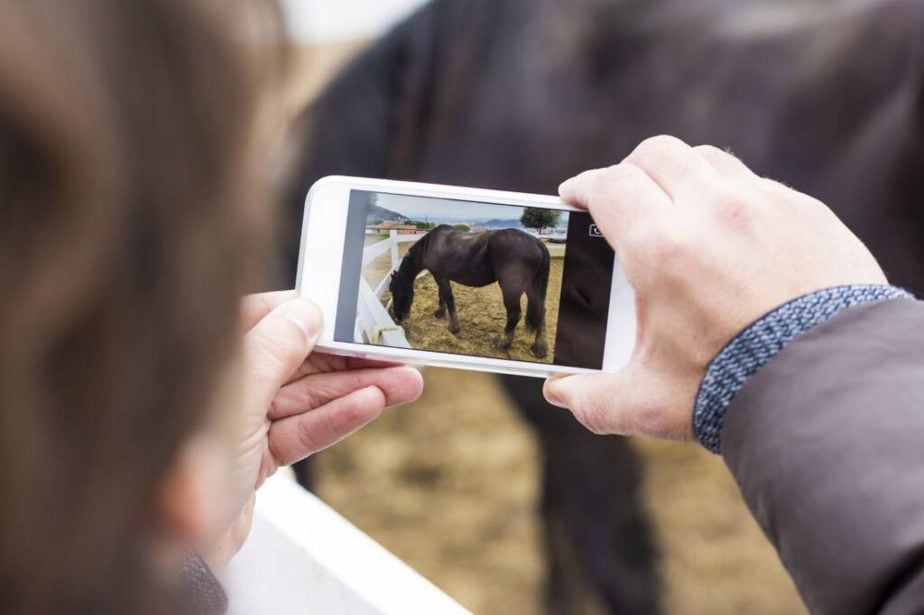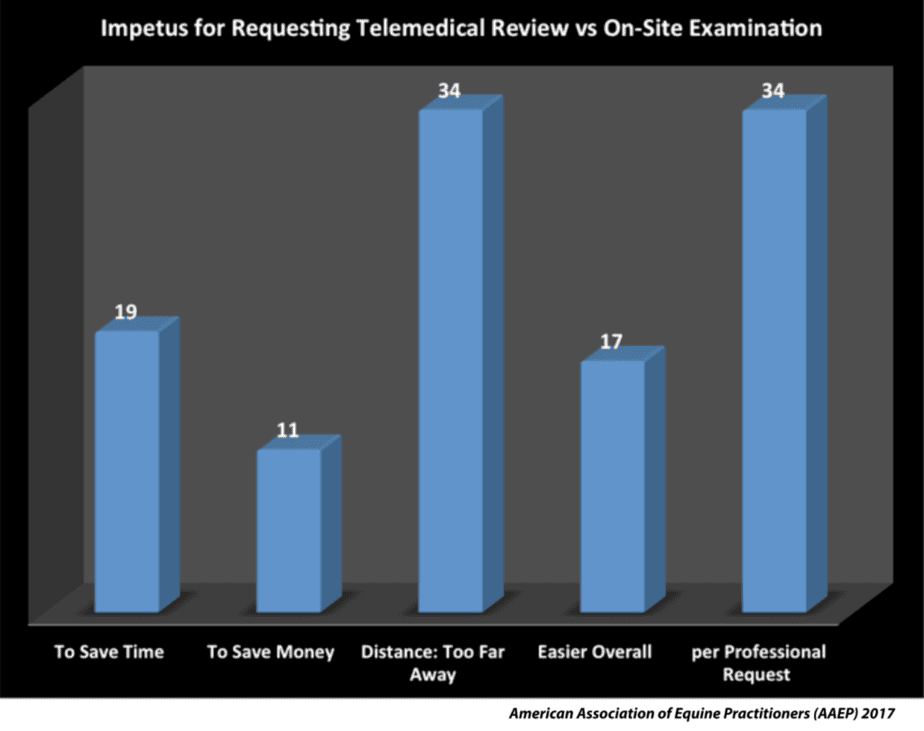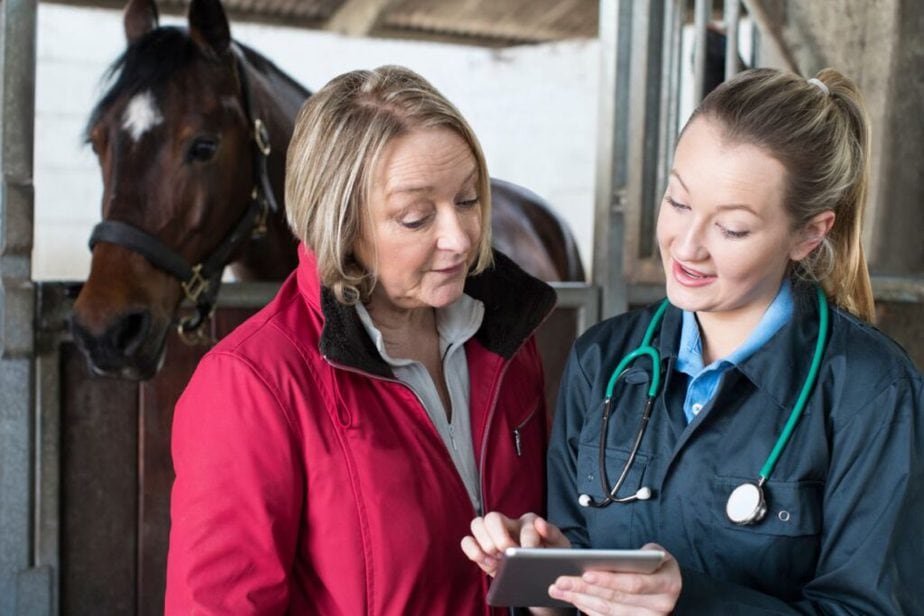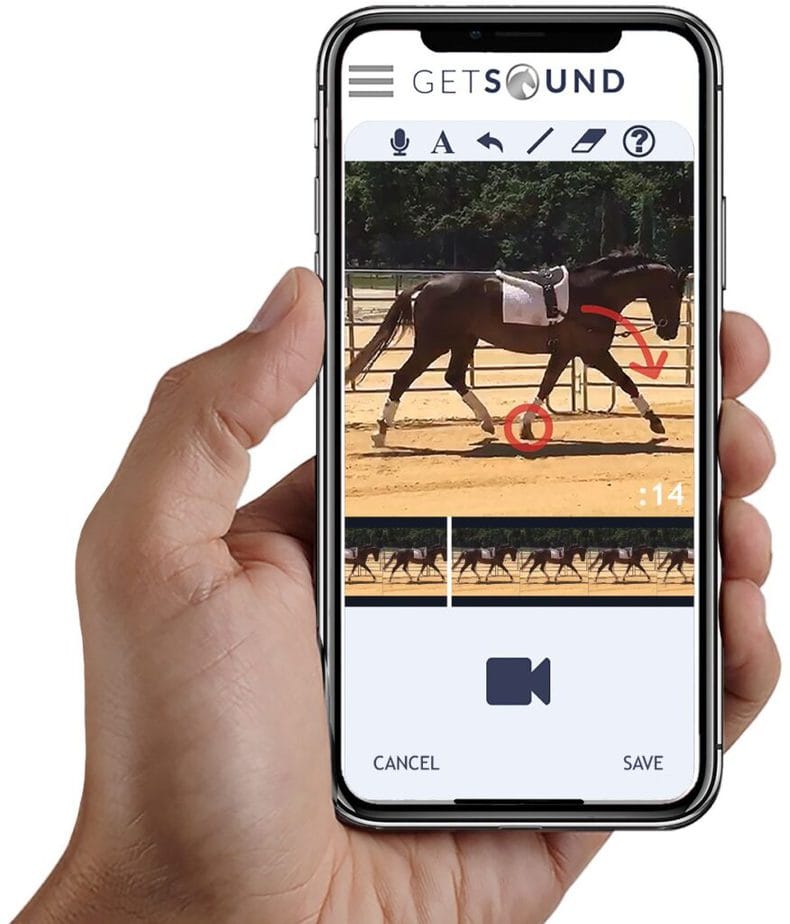—By. Dr. G. Robert Grisel, DVM
Most horse owners, trainers, and veterinarians have at one time or another contributed to the telemedical practice of veterinary medicine, whether they realized it or not. If your veterinarian has ever communicated with you via a phone call, text message, FaceTime dialogue, WhatsApp, email, etc. about a specific problem with your horse, then that doctor has practiced telemedicine.
So what exactly is telemedicine? We should review a few definitions at the onset of our discussion:
- Telehealth is a broad term that refers to the remote administration of medicine through technological means. In other words, practicing medicine while being physically removed from the patient.
- Telemedicine is a subcategory of telehealth and refers to the use of a tool, such as a smartphone or smartphone app, to provide telehealth services.
- Teleconsulting is another subcategory of telehealth that occurs when a primary (local) veterinarian utilizes telehealth tools to communicate with a second (remote) veterinarian for the purpose of gaining insights and advice regarding the medical care of a specific patient. Teleconsulting is a key ingredient in the appropriate practice of telehealth, because it provides the horse owner with access to specialists who may be better equipped to help their horse.
Nowadays, it is so easy to communicate via smartphone, and that includes communicating with your vet. If the smartphone trend continues, as much as 30% of equine veterinary medicine may be practiced through telemedical means within a few years. This is a good thing because telemedicine provides a variety of benefits for both the equestrian and the equine professional.

Benefits of Equine Telemedicine for the Horse Owner and Horse Trainer:
- The equestrian doesn’t have to assume the burden of making medical decisions regarding the health and soundness of the horse. By directly accessing your veterinary team, you pass the burden onto them. If they need to see the horse they can request that you schedule an appointment. If they don’t need to see the horse, they can still provide you with instant guidance regarding what to do next.
- Address small problems before they become big problems. The quickness and ease with which you can solicit professional guidance enable you to procure medical assistance relating to every concern that you have, no matter how casual or trivial it may seem. Current technology allows us to proactively seek out potential cases with the intention of detecting problems during their “window of treatment opportunity,” aka the phase when treatment will still be curative or at least highly effective. As you know, recognizing a problem after it has already reached the advanced and/or chronic phase can make successful management more difficult and in some cases impossible. If nothing else, it certainly makes the process more expensive.
- Improve your horse’s prognosis. By addressing problems earlier, you improve your chances of realizing a successful outcome. The goal is to reverse pathology (disease processes) while they are still reversible.
- Save time. Imagine the time you could save by instantly beaming your veterinarian or farrier to wherever you and your horse are. You don’t have to wait for the vet to show up. You also don’t have to take the time to load your horse up and haul it into the vet clinic. In the case that your horse does need to be evaluated on-site, pre-emptive telemedical review can shorten your appointment time considerably.
- Save money. Finally, we can save money. In fact, telemedicine allows you to have your horse assessed much more frequently, but at a fraction of the cost. This is because your professional team does not have to spend the time, energy, and money to evaluate your horse in person each and every time.

Benefits of Equine Telemedicine for the Veterinarian and Farrier:
- Professionals can be more vigilant in the way that they practice. Your professional can be far more attentive to your horse’s health and soundness. A typical veterinarian or farrier can physically evaluate 8-10 horses per day on average. The majority of time is spent traveling between barns. By contrast, a typical professional can evaluate as many as 40 animals per day through telemedical means. In theory, he or she can evaluate whichever horse they want at anytime they want. Your vet can check your horses on a weekly or daily basis if desired.
- Improves the horse’s prognosis. More attentive care enables the veterinary professional to detect problems promptly, thereby hastening diagnosis and improving the chances that ensuing treatment will be successful.
- Improves case success rate. Of course, every professional wants to be good at what they do; professional success is measured by the quality of life and performance that your horse exhibits on a regular basis. Keeping ahead of problems is critical to achieving this and is now possible through the implementation of telemedicine.
- Permits steady tracking of visual parameters. Professionals are also better equipped to recognize patterns with respect to the health and soundness of your horse. This is especially useful when trying to discern the effects of treatment modalities over time. Accordingly, telemedical assessment will become integral in the collection and analysis of research data over the coming years.
- Improves communication among professionals. Veterinary professionals can easily reach out to other professionals for consultation and collaboration. We can look forward to improved colleague-to-colleague dialogue on behalf of your horse. This form of communication is known as “teleconsulting” and is an essential part of providing horse owners and trainers with the best overall telehealth service.
- Saves time. Telemedicine also saves the professional’s time. Remember, not all cases require on-site examination. In fact, only between 10-15% of telemedical reviews actually prompt on-site visits. The professional can use telemedical assessment to decide if and when your horse needs to be seen. Moreover, as stated earlier, preemptive video review can dramatically expedite the examination process in the event that on-site assessment is warranted.
TheHorse.com conducted an online survey directed at horse owners back in 2015. The survey comprised only one question: “How do equestrians usually communicate with their veterinarian?” Out of 690 total responses, over half indicated that they communicated through a phone call. Perhaps the most intriguing aspect of the results was that 78% of the survey participants communicated via the use of their smart device, while only 21% communicated face-to-face. In theory, therefore, 3 out of 4 equestrians see their veterinary professional as a resource at the other end of their phone as opposed to someone they are expecting to meet out at the barn.

My veterinary practice, The Atlanta Equine Clinic, has been providing telehealth services for over 20 years, albeit the process has been somewhat rudimentary and cumbersome. When we started reviewing cases remotely back in 1998, we were primarily just trying to make life easier on ourselves. Like many equine practices nowadays, we are licensed to practice veterinary medicine in multiple states and intermittently travel to these states to administer care. Likewise, our out-of-state clients oftentimes ship their horses to our facility in Georgia for evaluation and treatment.
We began asking our clients to send photos or videos so that we could keep visual tabs on our patients in between our in-person appointments. The concept was extremely attractive: our doctors could evaluate as many horses as often as necessary and our clients felt as though they were constantly connected to our staff. Accordingly, our practice went from averaging 6 video reviews to almost 300 during the first half of 1999. Since the time that we started offering consultation services, telemedical traffic has increased more than 3600% within our practice.
In 2017, we decided to officially integrate a formal telehealth platform into our business model. As a starting point, we elected to summon our clients for feedback using an online survey platform. Our study revealed a number of illuminating facts:
- Approximately 70% of all of the survey participants had already summoned telemedical review by a professional at some point in the past. This suggests that the majority of equestrians have been attempting to utilize a veterinary service that most veterinary practices aren’t yet offering.
- Email and text messaging are the most popular methods for video submission, presumably because they provide direct access to veterinary counsel and can be sent from a smartphone. Of course, email and text messaging methods require that the client acquires the veterinarian’s email address and/ or cell phone number, respectively.
- The smartphone is the device of choice for submitting video clips (preferred by 75% of survey participants).
- The most popular telemedical service is pre-appointment evaluation, which has historically served to shorten appointment times considerably. By pre-emptively reviewing video footage, the veterinarian has already established the visual and mental portions of the exam before he or she has even arrived at the barn. This service may be especially useful in a teaching environment, where a large part of the conversation with the students could take place without the client having to wait.
- Telemedical guidance provided by the consulting veterinarian must be informative and (preferably) beyond what a friend or trainer could provide, but survey participants were rarely seeking a specific diagnosis.
- Ninety-eight of the survey participants stated that they would be willing to pay for telemedical services.
Now that we know equine telemedicine is coming and that it will be a valuable resource in our industry, how do we go about optimizing its implementation? The primary objectives of successful telemedical employment are two-fold:
- Give equestrians (the horse owner and/or trainer) what they want with respect to instant professional guidance, and
- Provide veterinary professionals with a platform that enables the convenient, ethical, and legal practice of remote veterinary medicine.

Giving Equestrians What They Want
So what do equestrians want with respect to veterinary telemedical services? To get an idea, I might suggest that you visit YouTube’s website and perform a search for the phrase “Lame Horse,” which is likely to generate about a quarter-million results. A few will be instructional clips posted by veterinarians for the purpose of client education; equine professionals wanting to express their personal opinions with respect to appropriate treatment strategies will have posted several others. The vast majority of videos listed under this key phrase, however, were posted by equestrians (mostly horse owners) with the intention of seeking guidance concerning a specific case of lameness. The latter observation suggests that there are numerous parties soliciting help over the internet as opposed to relying on their own veterinarian(s). After all, it is far easier to post a question online than it is to schedule an on-site visit that is likely to incur considerably more time and expense. This is an important consideration because it raises the following points of discussion:
- How much equine “medicine” is being practiced by non-veterinarians? In other words, exactly who is providing opinions on these online cases? How does the allocation of non-veterinary opinions affect the integrity of our medical profession?
- What are the primary reasons behind the horse owner’s decision to solicit “Dr. Google” instead of contacting their local veterinarian? Time and expense are fairly obvious arguments, but are there other incentives?
- What is the quality of “medicine” being practiced over the internet? Are the individuals providing opinions online trained to do so? What are their credentials and endorsements?
- Are any veterinarians providing opinions in this online setting? If so, are they legally authorized to do so?
- What can the veterinary industry do to meet the apparent demand for remote medical services? It is clear that the majority of equestrians who composed the YouTube posts were utilizing veterinary practices that did not offer instant telemedical services.
If nothing else, our simple query confirms that the equine veterinary industry is well behind the 8-ball with respect to providing desired medical services to an equestrian community living in the digital age.
Based on a study performed by The Atlanta Equine Clinic in 20171, the primary reason why horse owners submit video footage online (instead of just making a regular appointment with their veterinarian) is due to the fact that the vet is too far away when a problem becomes evident. Of course, the study also reported the expected arguments of time, money, and overall ease.

Generally speaking, equestrians want telemedical services to be:
- Easy. The process should be as easy as texting or placing a phone call. Nowadays video can be acquired on-site and sent within a few seconds using a smartphone.
- Instantaneous. “Is my horse lame? Is this an emergency? Can I just give him some Bute and see how he does?” Obtaining answers to questions like these on the spot can take the panic out of the situation and provide instant peace of mind.
- Informative. The guidance that professionals provide has to be informative. Preferably, it should be beyond the scope of what a friend or trainer could provide. That said, horse owners are rarely seeking a specific diagnosis over the phone. In most cases, they’re simply seeking advice that will help to determine what needs to be done next. Accordingly, veterinarians providing telemedical services don’t have to perform amazing feats of visual interpretation. Rather, the professional can usually accommodate the client with general information and reserve specific judgment for the on-site appointment.
- Inexpensive. Of course, nobody wants to spend too much on a service being provided at the other end of a phone. Still, any valuable service should have an associated expense.
- Documented Appropriately. If you’re going to get charged for the service, you will want detailed and secure records of your consultations for future reference.
- Not Restricted by Geography. Most horse owners will solicit whichever professional they think will provide the best guidance with respect to the issue at hand, regardless of the latter’s location (city, state, or country). We would hope that the primary veterinarian would serve this purpose, although this isn’t always the case.
This brings us to the second part of our discussion: What it is that veterinarians desire and have to have in order to practice telemedicine.

Giving Veterinarians What They Want and Need
Our 2017 study confirmed that equine veterinarians must find a way to administer valuable guidance to their clients instantly and from anywhere. For the equine veterinarian, who spends most of the time in the truck and/or barn, this service must be employed through the use of a smartphone. At first glance the process appears to be elementary: simply provide the client with an opinion in order to optimize the eventual outcome of the case. But, as a veterinarian, there is more to providing an opinion than meets the eye. For instance, consider the following two points:
- A veterinary opinion may seem quick and casual, but many years of training went behind crafting that opinion. Appropriately, a veterinary analysis should be worth more than a non-veterinary analysis. Consider what a lawyer’s time and opinion are typically worth…
- A veterinarian who provides an opinion regarding a specific case is effectually practicing veterinary medicine. It does not matter how casual that opinion may appear; it is still the practice of medicine and the veterinarian is on the “hook” for any ramifications stemming from his or her appraisal, even if it was provided at no financial charge to the client. Appropriately, it is crucial that horse owners acknowledge the fact that there are no such things as “unintentional” or “unofficial” veterinary opinions regarding a specific case. Any such opinion becomes the practice of medicine as soon as it leaves the veterinarian’s lips or fingertips. See “Telemedicine: Is It Legal? Yes. Can it be Illegal? Yes.” for a legal analysis of this point and others.
In order to work for the equine veterinarian, the practice of telemedicine will have to be:

- Easy. If it isn’t technically simple, veterinarians are not likely to do it (especially those that were not raised in the digital age).
- Quick. If the vet has to take a major portion of time out of the day to perform a video review, then he or she might as well just drive to the barn and assess the horse in person.
- Subject to Media Quality Control. Performing telemedical review is not as easy as it appears, and becomes exponentially more difficult as the quality of the video footage gets worse. Accurate assessment requires that the submitter knows exactly what the veterinarian wants to see and employs proper video acquisition techniques.
- Legal. Veterinarians in the technological age can provide an opinion on any horse from anywhere within a few seconds. However, since conveying this opinion qualifies as the practice of medicine, the veterinarian must satisfy an entire checklist of “Must Haves” in order to keep their activities above board. The first item on that checklist is a valid Veterinary-Client-Patient Relationship (VCPR), which is a convention that is designed to protect the equestrian (horse owner) from inappropriate and fraudulent veterinary medical activity. It requires that your veterinarian maintain a valid license and physically evaluate your animal (in person) at least once annually. Without this physical interaction, veterinarians are not permitted to give advice with respect to the diagnosis or treatment of a specific animal. They are also not permitted to prescribe medications for your horse. If they do this, they are at risk of losing their veterinary license.
- Ethical. The appropriate practice of veterinary medicine can be very challenging for equine practitioners because many horse owners are not shy about seeking second or alternate opinions without notifying their primary veterinarian. Global access to veterinary opinions ensures that the horse owner gets the best answers to their inquiries, but can also complicate things dramatically on the professional side of the equation. At the very least, the vet maintaining a current VCPR with an animal should be aware of all telemedical activity and opinions that pertain to that animal.
- Respectful of the Professional’s Privacy. The practice of equine medicine is hard enough without having to worry about clients contacting you at all hours or for every trivial cause. As a medical professional you want to be there for your clients, but you also want to have the ability to dictate the hours that you practice as well as the hours that you don’t. For the sake of your veterinarian’s sanity, it’s important that client-to-veterinary communications are managed appropriately.
- Transacted via eCommerce. Managing consultation fees via standard invoicing practices (such as through the vet’s front office) takes most of the convenience out of telemedicine… for all parties involved. The professional may spend five or six minutes performing the service, for instance, only to have the office staff follow-up spending 15 or 20 minutes properly documenting and invoicing the transaction. Subsequent communications relating to the same consultation must go through the same process, thereby convoluting the process even further. As you might imagine, the expense associated with providing the service quickly escalates for the professional, who must pay the staff enough to make each step of the process worth their while. The increased expense is then passed onto the horse owner who may have initially requested an answer to a fairly simple question. To keep the service user-friendly and economically feasible for both the horse owner and professional, therefore, payment for services must be rendered immediately and documented accurately without having to regularly engage office personnel.
- Documented Appropriately. Finally, records are an important part of any medical interaction with a client, but can also expose the vet to the risk of legal ramifications, especially if he or she has performed a service outside of the realms of a viable VCPR. In accordance with current veterinary regulations, records of each and every telemedical consultation must be maintained securely and off-site. Each record must also be kept within the client’s electronic account. Losing records as a result of dropping the phone into a water bucket, for instance, does not fall under the legal practice of veterinary medicine.
1Grisel GR. Current horse owner petition for telemedical assessment of equine lameness, in Proceedings. 63rd American Association of Equine Practitioners Annual Convention 2017 (San Antonio): 501-505.
Dr. Bob Grisel graduated from the University of Florida’s College of Veterinary Medicine with honors and having received multiple awards. He was offered an equine surgical position in the Atlanta area while working the 1996 Olympic Games and built The Atlanta Equine Clinic shortly thereafter. His clinic is a state-of-the-art, full service equine diagnostic, pharmacy, surgical, and emergency care facility located in Hoschton, GA. Bob’s recent publications focus on lameness, especially the correlation between abnormal gait characteristics and specific sources of pain in the horse.


















SOCIAL